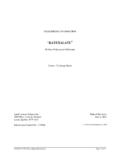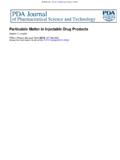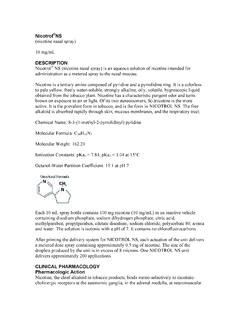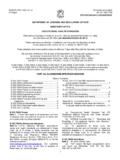Transcription of Myochrysine (sodium aurothiolamate) - Sanofi
1 PRESCRIBING INFORMATION PrMYOCHRYSINE (sodium aurothiomalate injection, Mfr. Std.) 10, 25 and 50 mg/mL Anti-Rheumatic Agent (disease modifying) Sanofi -aventis Canada Inc. Date of Revision: 2150 St. Elzear Blvd. West November 29, 2007 Laval, Quebec H7L 4A8 Submission Control No.: 114637 s-a Version dated November 29, 2007 2 NAME OF DRUG PrMYOCHRYSINE Sodium aurothiomalate injection, Mfr. Std. 10, 25 and 50 mg/mL THERAPEUTIC CLASSIFICATION Anti-rheumatic agent (disease modifying) ACTIONS AND CLINICAL PHARMACOLOGY Sodium aurothiomalate exhibits anti-inflammatory, antiarthritic and immunomodulating effects. The predominant clinical effect of Myochrysine (sodium aurothiomalate) appears to be suppression of the synovitis in the active stage of the rheumatoid disease. The precise mechanism of action is unknown but it has been suggested that the drug may act by inhibiting cell-mediated and humoral immune mechanisms.
2 Additional modes of action include alteration or inhibition of various enzyme systems, suppression of phagocytic activity of macrophage and polymorphonuclear leukocytes, and alteration of collagen biosynthesis. The metabolic fate of sodium aurothiomalate in humans is unknown but it is believed not to be broken down to elemental gold. It is very highly bound to plasma proteins. Sixty to 90% is excreted very slowly by the renal route while 10 to 40% is eliminated in the feces mostly via biliary secretion. The biologic half-life of gold following a single 50 mg dose of parenteral gold has been reported to range from 6 to 25 days. It increases following successive weekly doses. The appearance of clinical effect is slow. It may take at least 8 weeks to become significant and the maximum benefits may not be achieved for at least 6 months. INDICATIONS Myochrysine (sodium aurothiomalate) is indicated in the treatment of both adult and juvenile rheumatoid arthritis.
3 Myochrysine may also be of benefit in the treatment of patients with psoriatic arthritis or Felty's syndrome. 3It is usually used for treating patients who show evidence of continued or additional disease activity despite conservative drug therapy, with salicylates or other anti-inflammatory agents. Myochrysine may induce partial or complete remission of rheumatoid arthritis. In chronic advanced rheumatoid arthritis, it may prevent further damage to affected joints; however, it does not reverse existing damage. CONTRAINDICATIONS Myochrysine (sodium aurothiomalate) is contraindicated in patients with known hypersensitivity to gold. It is also contraindicated in patients who have experienced the following serious adverse effects with previous gold therapy: bone marrow aplasia or other hematological disorders, exfoliative dermatitis, necrotizing enterocolitis or pulmonary fibrosis.
4 Pregnancy: while reassuring, the information concerning the administration of gold during pregnancy is sparse and largely anecdotal; there have been no controlled prospective studies of the effect of sodium aurothiomalate on human fetal development. In rats, gold compounds have been shown to cause hydrocephalus and microphthalmia when administered at a dose of 25 mg/kg per day from day 6 through day 15 of gestation; in rabbits, they caused gastroschisis, umbilical hernia, anomalies of the brain, heart, lung and skeleton, microphthalmia and limb defects when given at 20 to 45 mg/kg per day from day 6 through day 18 of gestation. Gold is known to cross the placenta and it can reach significant concentrations in the fetus. Gold therapy is seldom needed during pregnancy. If its use is nevertheless contemplated, the risk/benefit ratio should be considered keeping in mind the potential of sodium aurothiomalate for teratogenicity.
5 Nursing mothers: Parenterally administered gold is excreted in human breast milk and has been detected in the blood of a nursing infant. Although problems in humans have not been documented, the use of Myochrysine in nursing mothers is not usually recommended because of the potential for serious adverse effects in the infant. 4 WARNINGS The following conditions may aggravate or precipitate adverse reactions to Myochrysine (sodium aurothiomalate), or their symptoms may mask the forwarning signs of gold toxicity: - Blood dyscrasias or a history of agranulocytosis, hemorrhagic diathesis or drug induced granulocytopenia or anemia; - Renal disease; - Hepatic dysfunction; - Systemic lupus erythematosus; - Significant dermatitis including urticaria or eczema. Any of the above conditions should be considered as a relative contraindication to the use of Myochrysine .
6 In such cases, treatment should be initiated with extreme caution and only after careful assessment of expected benefits versus the potential risks. Rarely, anaphylactic shock, syncope, bradycardia, thickening of the tongue, difficulty in swallowing and breathing, and angioedema may occur in the minutes that follow the injection of Myochrysine . If an anaphylactic reaction occurs, treatment should be discontinued. A vasomotor (nitritoid) reaction may occur within several minutes of a Myochrysine injection. The nitritoid reaction is characterized by flushing, tachycardia and faintness. When it occurs, caution should be exercised before resuming therapy in patients with compromised cardiovascular status. Carcinogenicity/Tumorigenicity: Renal adenoma and adenocarcinoma have been reported in rats after prolonged administration of frequent, high doses of parenteral gold compounds (2 mg/kg/week for 45 weeks followed by 6 mg/kg/day for 47 weeks in one study; 3 mg/kg/day or 6 mg/kg/day for up to 2 years in a second study).
7 The adenomas were similar to those produced in rats by chronic administration of other heavy metals such as lead or nickel. The relevance of these findings to man is unknown. Renal adenomas have not been reported in humans receiving therapeutic doses of sodium aurothiomalate. PRECAUTIONS Myochrysine (sodium aurothiomalate) should be administered only to selected patients who are under the supervision of a physician experienced with chrysotherapy and thoroughly familiar with the toxicity and benefits of the drug. Patient monitoring: Toxic reactions to Myochrysine are relatively frequent and, in certain cases, may be quite severe. Thus emphasis should be placed on careful clinical and laboratory monitoring and early detection of adverse reactions. 5 Baseline evaluation should include a biochemical profile to identify any preexisting conditions. Before receiving gold, patients should also have a complete blood cell count with differential, platelet count, hemoglobin determination and urinalysis for protein, white cells, red cells and casts; these tests should be repeated before each injection and patients should have an examination of the skin and buccal mucosa for skin rash, bruising or mouth ulcers.
8 They should be questioned for the presence of pruritus, rash, stomatitis or metallic taste. Dermatitis and lesions of the mucous membranes are common and may be serious; pruritus may precede the early development of a skin reaction. Renal toxicity ranges from mild proteinuria to the nephrotic syndrome; prognosis is usually good. Hematologic reactions have been observed rarely but fatalities have ensued. Other severe toxic manifestations include cholestatic jaundice, enterocolitis and interstitial lung disease. If toxicity develops, Myochrysine should be discontinued immediately and symptomatic treatment be given as required. If the reaction to gold therapy is not of a serious type, injections may be cautiously resumed 2 or 3 weeks after the toxic reaction has subsided. In these circumstances, from 5 to 10 mg of gold is administered; if the challenge dose is tolerated, Myochrysine may be administered cautiously in larger doses on subsequent injections.
9 Severe reactions are a contraindication to further gold therapy. Interference with drugs: The concurrent use of D-penicillamine or other drugs with potential bone marrow toxicity may increase the potential for serious hematologic and/or renal adverse reactions. ADVERSE REACTIONS The most frequent adverse reactions with Myochrysine (sodium aurothiomalate) involve the skin (ranging from simple rash to severe exfoliative dermatitis) and mucous membranes (ulcers) and may affect 30% of patients. Renal effects are next in frequency with proteinuria being observed in 10 to 15% of patients. The severe adverse reactions are those affecting the bone marrow (agranulocytosis, thrombocytopenia and aplastic anemia), exfoliative dermatitis, enterocolitis, liver failure, anaphylactoid reactions and nephropathy; these are rare but may be fatal. It has been proposed that serious reactions may be the result of failure to discontinue therapy when earlier less serious symptoms occur.
10 Close patient monitoring will not eliminate untoward effects but may help reduce their severity (See PRECAUTIONS Section). The following adverse reactions have been reported: 6 Skin and Mucous Membranes: Pruritus and rash (30%) ranging from simple erythema to exfoliative dermatitis, and mucous membrane lesions (20%) including stomatitis. Hematological: Leukopenia (2%), thrombocytopenia (1 - 3%), eosinophilia, agranulocytosis and aplastic anemia. Renal: Proteinuria (10 - 15%), nephrotic syndrome, acute renal failure. Allergic: Anaphylactoid and vasomotor (nitritoid) reactions. Digestive: Metallic taste, diarrhea, enterocolitis, cholestatic jaundice. Miscellaneous: Other very rare reactions include encephalitis, peripheral neuropathy and pulmonary infiltrates. Chrysiasis (affecting the skin and mucous membranes) and corneal gold deposits have been noted in some patients.
![Thymoglobulin (anti-thymocyte globulin [rabbit]) - …](/cache/preview/a/b/2/e/e/b/8/2/thumb-ab2eeb82468088f352549e7d8dab340f.jpg)














